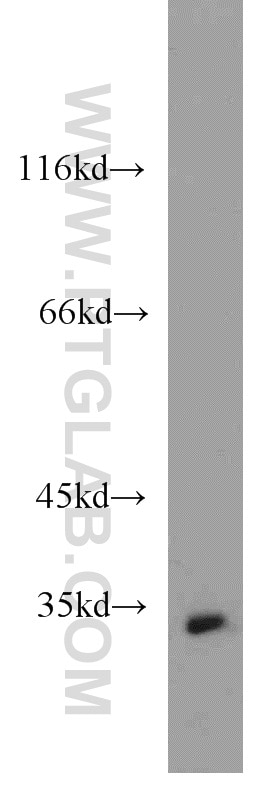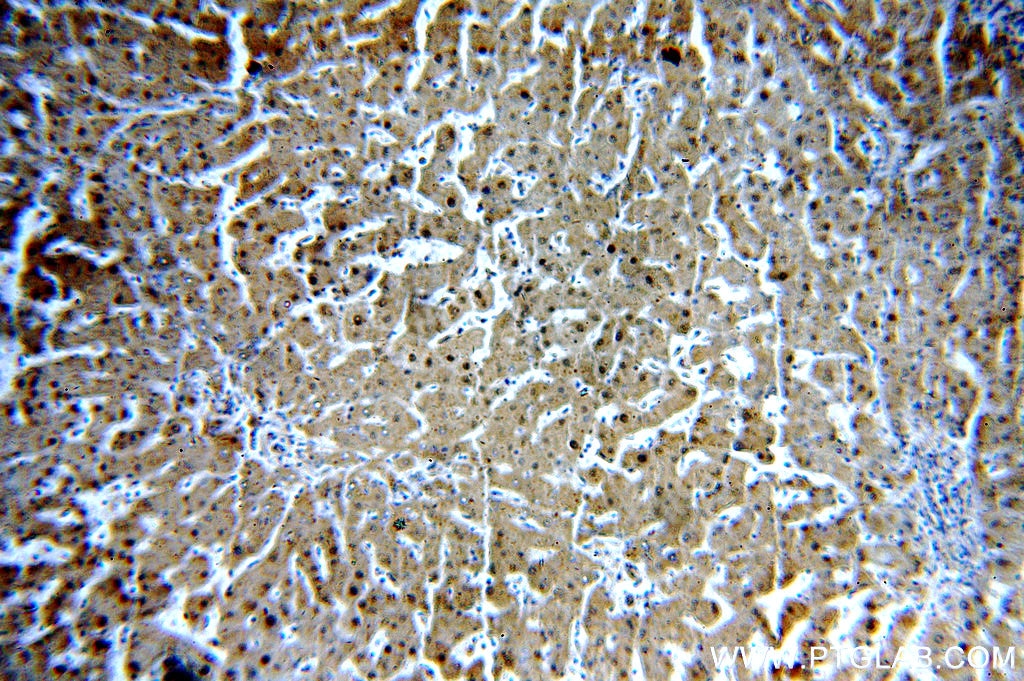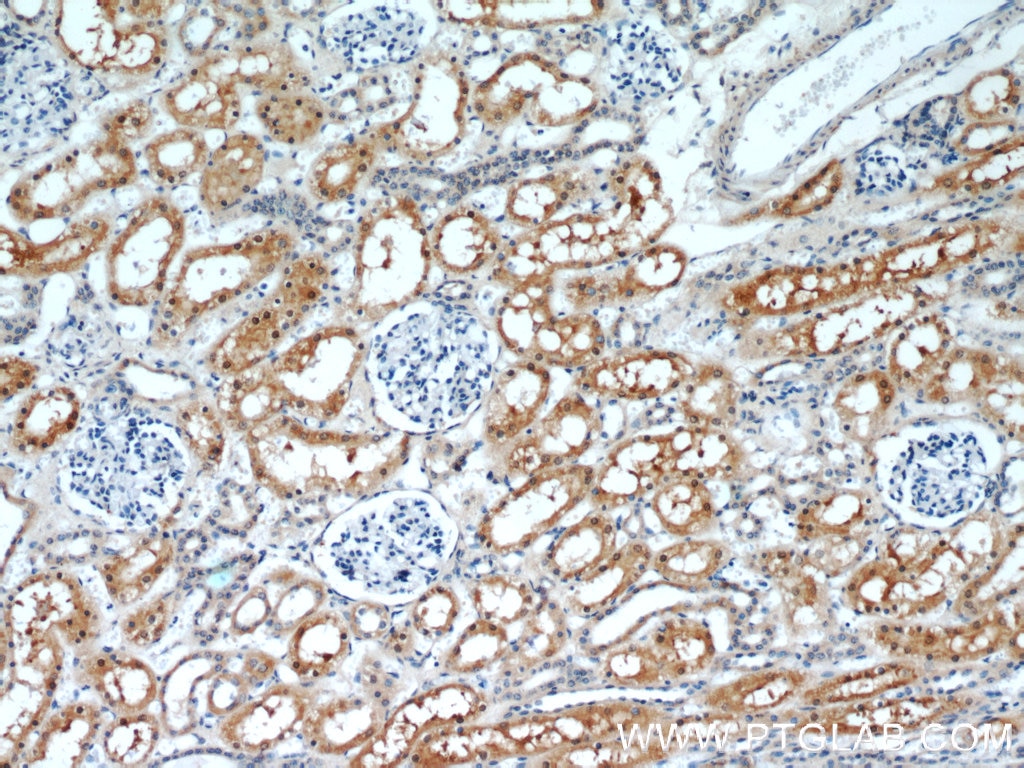RGN/SMP30 Polyklonaler Antikörper
RGN/SMP30 Polyklonal Antikörper für IHC, IP, WB, ELISA
Wirt / Isotyp
Kaninchen / IgG
Getestete Reaktivität
human, Maus, Ratte und mehr (1)
Anwendung
WB, IP, IHC, IF, ELISA
Konjugation
Unkonjugiert
Kat-Nr. : 17947-1-AP
Synonyme
Galerie der Validierungsdaten
Geprüfte Anwendungen
| Erfolgreiche Detektion in WB | Mauslebergewebe, Maus-Dünndarmgewebe, Rattenlebergewebe |
| Erfolgreiche IP | Mauslebergewebe |
| Erfolgreiche Detektion in IHC | Rattennierengewebe, humanes Lebergewebe, humanes Leberzirrhosegewebe, humanes Nierengewebe Hinweis: Antigendemaskierung mit TE-Puffer pH 9,0 empfohlen. (*) Wahlweise kann die Antigendemaskierung auch mit Citratpuffer pH 6,0 erfolgen. |
Empfohlene Verdünnung
| Anwendung | Verdünnung |
|---|---|
| Western Blot (WB) | WB : 1:3000-1:10000 |
| Immunpräzipitation (IP) | IP : 0.5-4.0 ug for 1.0-3.0 mg of total protein lysate |
| Immunhistochemie (IHC) | IHC : 1:50-1:500 |
| It is recommended that this reagent should be titrated in each testing system to obtain optimal results. | |
| Sample-dependent, check data in validation data gallery | |
Veröffentlichte Anwendungen
| WB | See 10 publications below |
| IHC | See 1 publications below |
| IF | See 1 publications below |
Produktinformation
17947-1-AP bindet in WB, IP, IHC, IF, ELISA RGN/SMP30 und zeigt Reaktivität mit human, Maus, Ratten
| Getestete Reaktivität | human, Maus, Ratte |
| In Publikationen genannte Reaktivität | human, Maus, Rind |
| Wirt / Isotyp | Kaninchen / IgG |
| Klonalität | Polyklonal |
| Typ | Antikörper |
| Immunogen | RGN/SMP30 fusion protein Ag12423 |
| Vollständiger Name | regucalcin (senescence marker protein-30) |
| Berechnetes Molekulargewicht | 299 aa, 33 kDa |
| Beobachtetes Molekulargewicht | 33 kDa, 25 kDa |
| GenBank-Zugangsnummer | BC073173 |
| Gene symbol | RGN |
| Gene ID (NCBI) | 9104 |
| Konjugation | Unkonjugiert |
| Form | Liquid |
| Reinigungsmethode | Antigen-Affinitätsreinigung |
| Lagerungspuffer | PBS mit 0.02% Natriumazid und 50% Glycerin pH 7.3. |
| Lagerungsbedingungen | Bei -20°C lagern. Nach dem Versand ein Jahr lang stabil Aliquotieren ist bei -20oC Lagerung nicht notwendig. 20ul Größen enthalten 0,1% BSA. |
Hintergrundinformationen
Regucalcin (RGN), also known as SMP30, is a highly conserved, calcium-binding protein, that is preferentially expressed in the liver and kidney. SMP30 is preferentially localized in hepatocytes and renal proximal tubular epithelial cells. It is known to be related to aging, hepatocyte proliferation and tumorigenesis. It may be useful for HCC serologic screening, especially for the patients with AFP Negative. RGN encodes two isoforms: 33 kDa and 25 kDa.
Protokolle
| Produktspezifische Protokolle | |
|---|---|
| WB protocol for RGN/SMP30 antibody 17947-1-AP | Protokoll herunterladen |
| IHC protocol for RGN/SMP30 antibody 17947-1-AP | Protokoll herunterladen |
| IP protocol for RGN/SMP30 antibody 17947-1-AP | Protokoll herunterladen |
| Standard-Protokolle | |
|---|---|
| Klicken Sie hier, um unsere Standardprotokolle anzuzeigen |
Publikationen
| Species | Application | Title |
|---|---|---|
Transl Lung Cancer Res Senescence marker protein 30 inhibits tumor growth by reducing HDAC4 expression in non-small cell lung cancer. | ||
Ecotoxicol Environ Saf Hexavalent chromium triggers hepatocytes premature senescence via the GATA4/NF-κB signaling pathway mediated by the DNA damage response. | ||
Ecotoxicol Environ Saf Identification and functional analysis of senescence-associated secretory phenotype of premature senescent hepatocytes induced by hexavalent chromium. | ||
J Endocrinol Hepatic thyroid signaling of heat-stressed late pregnant and early lactating cows. | ||
Int Immunopharmacol Senescence marker protein 30 (SMP30) protects against high glucose-induced apoptosis, oxidative stress and inflammatory response in retinal ganglion cells by enhancing Nrf2 activation via regulation of Akt/GSK-3β pathway | ||
Toxicol Lett Dioscin, a natural steroid saponin, shows remarkable protective effect against acetaminophen-induced liver damage in vitro and in vivo. |












